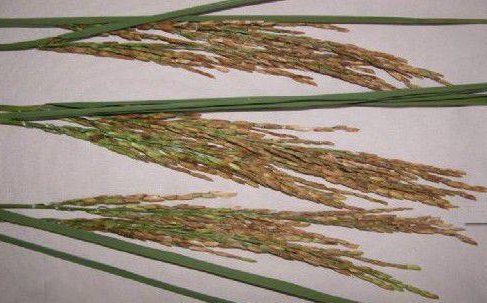Rice chilling injury refers to the low temperature effect of rice below the minimum critical temperature of growth, which leads to the failure of normal growth and development of rice and the reduction of production. According to the different periods of damage, it can be divided into delayed cold damage, obstacle cold damage and mixed cold damage. First, the type and characteristics of rice chilling damage 1. Delayed chilling damage to rice in the vegetative growth period, sometimes including the reproductive growth period, encounters lower temperature hazards in a longer period of time, weakens the physiological activity of rice plants, delays the growth of flowering, delays flowering in heading, and cannot be fully grouted. Mature leads to significant production cuts. There is also a normal temperature in the early stage, and the heading is delayed, and the late stage is delayed due to abnormal low temperature. Rice suffers from delayed cold damage, increased glutinous grains, decreased 1000-grain weight, poor rice quality, and severe yield reduction. 2, barrier-type cold damage rice in the reproductive growth period, suffering from a relatively short period of abnormally strong low temperature, so that the physiological mechanism of the flower is destroyed, resulting in sterile flowering, a large number of empty shells, and severely reduced production. According to the period of low temperature hazard, it is divided into chilling injury at booting stage and chilling injury at heading and flowering stage. The temperature at booting stage is lower than 17 °C for 5-6 days, which will cause large spikelets to degenerate or unable to form normal pollen grains and egg cells, resulting in a lot of empty space. Shell; when the temperature is below 20 °C during the flowering stage, a large number of husks will not open, the anthers will not split, and the pollen rate of pollen or pollen will not drop greatly, so the infertility will result in reduced yield. 3. Mixed chilling damage In the same year, delayed chilling injury and obstacle chilling injury occur simultaneously. In the early stage of growth, the growth of the roots and stems of the roots and leaves is delayed, the rice panicle differentiation is delayed, the heading is delayed, and the yield is affected. Booting, heading, and low temperature during flowering can cause spikelet infertility or partial infertility, delaying maturity, and producing a large number of empty seeds. Second, the effect of cold damage on rice nutrition and physiology 1. Low temperature weakens photosynthesis, mainly caused by low temperature causing protein denaturation in chloroplasts, and decreased enzyme activity, thereby reducing plant photosynthesis intensity. 2, low temperature reduces respiratory intensity, respiration is an indispensable condition for maintaining plant growth and development. During the growth process of rice, the temperature decreases from the appropriate temperature by 10 ° C, and its respiratory intensity is reduced by 1.6 to 2.0 times. 3. The effect of low temperature on mineral nutrient absorption. The energy of root absorption of mineral elements comes from respiration, the low temperature makes the respiration of roots weaken, and the energy required to supply plants to absorb mineral nutrients is reduced, resulting in a decrease in the absorption rate of nutrients by plants. The plant nutrient balance was destroyed. 4, the impact of low temperature on nutrient operation, low temperature not only reduces the photosynthetic intensity of rice plants, affects the absorption of mineral nutrients by roots, but also hinders the transport of photosynthetic products and nutrients to growing organs, reducing the speed of operation. Third, measures to prevent cold damage 1. Establish and improve the breeding system for improved varieties, purify the existing varieties, maintain and enhance the seed and resistance of the original varieties, and introduce and cultivate early-maturing varieties with strong cold resistance. 2, autumn land preparation, autumn preparation soil autumn bed, after the spring, grab the accumulation of temperature, early seedlings, early spring live snow buckle film to promote the temperature rise, when the temperature is stable through 5 ~ 6 ° C, start seedling sowing, when the temperature is stable through 13 ° C When transplanting began. 3. Fertilization technology to prevent cold damage. (1) Control the application of nitrogen fertilizer. In the case of cold injury, it is usually necessary to reduce 20-30% of total nitrogen fertilizer, 70-80% of the remaining nitrogen fertilizer is used as base fertilizer and manure fertilizer, and 20-30% is 10-20 days before heading. (2) Increasing the application of phosphate fertilizer, phosphorus can increase the content of soluble sugar in rice, thereby improving the cold resistance of rice, and also promoting early maturity, applying all the amount of base fertilizer to the root-dense soil layer once. In the middle, it can protect against low temperature and cold damage: (3) with potassium fertilizer and trace elements, potassium can promote the metabolic synthesis of carbohydrates, improve the stress resistance of crops, and apply 60~70% of the total amount as the base fertilizer; the remaining 30~ 40% later applied as a top dressing. At the same time, appropriate combination of some trace elements to improve the quality of rice. 4. Increase water temperature and ground temperature. Set up a sunbathing pool, extend the waterway, make up the membrane, widen the water inlet, roll the water into the field, and use the backwater irrigation to increase the warmth of the field water during the day. Deep water irrigation is carried out during the sensitive period of obstacle-type cold damage, with a water depth of 17-20 cm. Foot Protective Shoes,Leather Safety Shoes,Smash Proof Work Shoes,High Cut Safety Boots Dongying Hong Xing Labor Protection Products Co.,Ltd. , https://www.hongxinglabor.com